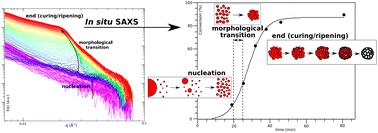当前位置:
X-MOL 学术
›
Polym. Chem.
›
论文详情
Our official English website, www.x-mol.net, welcomes your feedback! (Note: you will need to create a separate account there.)
In situ SAXS investigation of vinyl acetate polymerization-induced self-assembly
Polymer Chemistry ( IF 4.6 ) Pub Date : 2024-02-07 , DOI: 10.1039/d3py01381b Fabrice Brunel 1 , Paul Galanopoulo 1 , Edgar Espinosa Rodriguez 1 , Muriel Lansalot 1 , Franck D'Agosto 1
Polymer Chemistry ( IF 4.6 ) Pub Date : 2024-02-07 , DOI: 10.1039/d3py01381b Fabrice Brunel 1 , Paul Galanopoulo 1 , Edgar Espinosa Rodriguez 1 , Muriel Lansalot 1 , Franck D'Agosto 1
Affiliation

|
In situ small angle X-ray scattering (SAXS) was used to investigate the formation of higher-order morphologies in vinyl acetate (VAc) polymerization-induced self-assembly (PISA). Poly(ethylene glycol) (PEG) bearing a xanthate chain end was used as a hydrophilic macromolecular chain transfer agent in the macromolecular design via interchange of xanthates (MADIX)-mediated aqueous emulsion polymerization of VAc (see P. Galanopoulo, et al., Poly. Chem., 2020, 11, 3922–3930). In situ SAXS monitoring confirmed that the PISA process occurs in three steps: the nucleation of PEG45-b-PVAc200 block copolymer primary particles, a rapid morphological transition, and a final step in which the nano-objects grow slowly to their final dimensions. The transition step appears to be critical for the formation of higher-order morphologies through the aggregation of primary particles into larger clusters and their subsequent reorganization. Our results show that the transition step is extremely fast, making it highly sensitive to small perturbations. This explains why higher-order morphologies are usually obtained within a narrow window of conditions and often as a mixture. Furthermore, the morphological evolution observed in parallel static experiments appears to be more gradual than in in situ SAXS experiments, suggesting that in our system the sampled latexes were not thermodynamically stable and continued to evolve after sampling. Therefore, the sampling method may not provide a realistic view of the morphological transition during the reaction process in this system.
中文翻译:

乙酸乙烯酯聚合诱导自组装的原位 SAXS 研究
原位小角 X 射线散射 (SAXS) 用于研究醋酸乙烯酯 (VAc) 聚合诱导自组装 (PISA) 中高阶形态的形成。带有黄原酸酯链端的聚乙二醇 (PEG) 在大分子设计中被用作亲水性大分子链转移剂,通过黄原酸酯交换 (MADIX) 介导的 VAc 水乳液聚合 (参见 P. Galanopoulo等人,高分子化学, 2020, 11 , 3922–3930). 原位SAXS 监测证实,PISA 过程分三个步骤进行:PEG 45 - b -PVAc 200嵌段共聚物初级颗粒的成核、快速形态转变以及纳米物体缓慢生长至最终尺寸的最后一步。通过初级粒子聚集成更大的团簇及其随后的重组,转变步骤似乎对于形成高阶形态至关重要。我们的结果表明,过渡步骤非常快,使其对小扰动高度敏感。这解释了为什么高阶形态通常是在狭窄的条件窗口内获得的,并且通常是作为混合物获得的。此外,在平行静态实验中观察到的形态演化似乎比原位SAXS 实验更加渐进,这表明在我们的系统中,采样的乳胶在热力学上不稳定,并且在采样后继续演化。因此,采样方法可能无法提供该系统反应过程中形态转变的真实视图。
更新日期:2024-02-07
中文翻译:

乙酸乙烯酯聚合诱导自组装的原位 SAXS 研究
原位小角 X 射线散射 (SAXS) 用于研究醋酸乙烯酯 (VAc) 聚合诱导自组装 (PISA) 中高阶形态的形成。带有黄原酸酯链端的聚乙二醇 (PEG) 在大分子设计中被用作亲水性大分子链转移剂,通过黄原酸酯交换 (MADIX) 介导的 VAc 水乳液聚合 (参见 P. Galanopoulo等人,高分子化学, 2020, 11 , 3922–3930). 原位SAXS 监测证实,PISA 过程分三个步骤进行:PEG 45 - b -PVAc 200嵌段共聚物初级颗粒的成核、快速形态转变以及纳米物体缓慢生长至最终尺寸的最后一步。通过初级粒子聚集成更大的团簇及其随后的重组,转变步骤似乎对于形成高阶形态至关重要。我们的结果表明,过渡步骤非常快,使其对小扰动高度敏感。这解释了为什么高阶形态通常是在狭窄的条件窗口内获得的,并且通常是作为混合物获得的。此外,在平行静态实验中观察到的形态演化似乎比原位SAXS 实验更加渐进,这表明在我们的系统中,采样的乳胶在热力学上不稳定,并且在采样后继续演化。因此,采样方法可能无法提供该系统反应过程中形态转变的真实视图。



























 京公网安备 11010802027423号
京公网安备 11010802027423号